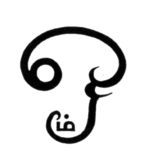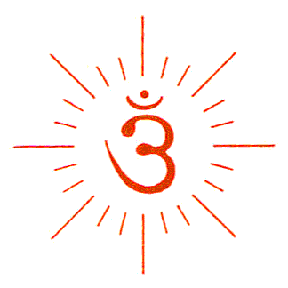-
- -
Guru Nanak's concept and vision of the Supreme Being is embodied in terse terms in the Sikh Fundamental Creed, Mool Mantra, literally meaning the Root Formula. Because of its importance as a basic theological declaration around which revolves the whole Sikh philosophical thought, it is most appropriately placed in the very beginning of the Sikh scripture, the Shri Guru Granthji.
"Ek Onkar Satnam Karta Purush Nirbhau Virvair Akal Murat, Ajuni Saibhang Gurprasad"
(There is One and only One God who is transcendent as well as immanent. True and Eternal Name. Creator and Person. Without Fear and without Enmity. Timeless Form, Unborn, Self-existent. Realized by Divine Grace.)
Besides Mool Mantra there is another term Bij Mantra (Seed Formula) which is occurs in Guru Arjun's composition 'Sukhmani' (Pearl of Peace). The original text where it appears runs as :
Bij Manter sarab ko Gyan. Chahu Varona meh japey kou Naam."
(All can be enlightened with Bij Mantra. Anyone from four castes can meditate on it.)
The term Bij Mantra signifies any word or phrase out of which develops a prayer meant to be meditated upon or chanted to invoke Divine blessing. Almost all the Sikh scholars and theologians are unanimous in recognizing Ek-Onkar as the Bij Mantra out of which has emanated Guru Nanak's vision of the Supreme Being in the form of Mool Mantra. That is why it stands majestically at the head of the Mool Mantra and forms its integral part.
It is constituted of two components - Ek and Onkar. Ek means one, and is written as a numerical figure '1'. Onkar stands for the Primal mystical Divine Name of God referred to as Brahma in the Vedic literature. In order to grasp fully the underlying spiritual significance and meaning of Ek-Onkar each of its components needs to be studied in depth, beginning with Onkar.
The root of Onkar is traceable to the Hindu sacred syllable Om, also written as Aum. Historically, in the beginning, Om was used as a reply of approval or consent. It is equivalent to the English word 'Amen' uttered at the end of a Christian prayer, meaning 'so be it'. At a later stage, with the evolution of Indian philosophic thought, the sages of Upanishads pronounced it as an adequate symbol of the Absolute Transcendent Reality, Brahma. It is considered as the unity of all sound to which all matters and energy are reduced in their primordial form, hence fit as a symbol for Atman (soul) or Brahma, the Supreme Being, which is the unity of all existence. These - and possibly some other - considerations led the Vedic sages to accord to Om the highest Divine reverence and worship. As a very sacred and powerful Mantra it forms part of daily worship and meditation by Hindu devotees. It is treated as the holiest symbol of Divinity calling it Nada Brahma or Shabda Brahma in the form of sound.
Universally acknowledged as the voice of God, it reverberates across the Cosmos. It also sums up the entire process of Creation, Preservation and Destruction.
The holy Vedas begin with OM. The Shri Guru-Granth-Ji begins with Ik Om Kar. The Bible also says, “In the beginning was the Word; and the Word was with God; and the Word was God.” Amen for Christians, Ameen for Moslems and the Jews it is one and the same.
Yoga Meditation aimed at Self-Realization lays great emphasis on this single syllable. Reciting the mantra repeatedly mind is focused on Prana, the breath of Life, and lifts it up to the highest level of Cosmic Consciousness. And therefore, OM is known as the Pranava Mantra.
A and U combining to become O has deep meaning and special significance. It depicts the inseparable bondage between the individual Soul and Life of the living being. Life clings to the Soul and the mortal body, the M, clings to Life. While the body wears out in one life span, Life, manifest as it is as the Mind-stuff, sticks with the Soul until final liberation. The Soul takes with it the Mind-stuff or the Spiritual Body of the individual to salvation, which, according to the Hindu, Sikh and Buddhist belief, may take many a birth.
At one place Nanak emphatically affirms :
"Sahib mera Eko hai, Eko hai Bhai, eko hai."
(My Master is One, One only, Oh Brother, He is Sole.)
Ek-Onkar(Omkar) represents the Supreme Being, the Sole Absolute Eternal Reality which, while manifesting itself in multiplicity as Onkar, is still in its essence 'Sole and Absolute'; Transcendent as well as Immanent. Impersonal is also Personal in Ek-Onkar.
Thanks
Note : "Omkar" is usually written as such but is often pronounced as 'Onkar' using the rules of sandhi. We even find it as such in Sanskrit texts. When the m consonant precedes a velar consonant, that is ka, kha, ga, gha, it turns into the velar nasal consonant, that is 'n', thus Onkar. While it may be alternatively spelt as Omkar, it is still pronounced as Onkar, because the 'm' also stands for any conjunct or half nasal consonant. In this case as I've said, the velar n at the end of the k line.


DevaNagari 'OM'

Tamil 'OM'

Tibeti 'OM'
( The above pictures are of Punjabi ik+om, Devanagari Om, Tamil Om and Tibeti Om...
Can anyone please help me with the symbols of 'OM' in Japanese, Han etc. scripts ?? )
- -
- -
- -
Guru Nanak's concept and vision of the Supreme Being is embodied in terse terms in the Sikh Fundamental Creed, Mool Mantra, literally meaning the Root Formula. Because of its importance as a basic theological declaration around which revolves the whole Sikh philosophical thought, it is most appropriately placed in the very beginning of the Sikh scripture, the Shri Guru Granthji.
"Ek Onkar Satnam Karta Purush Nirbhau Virvair Akal Murat, Ajuni Saibhang Gurprasad"
(There is One and only One God who is transcendent as well as immanent. True and Eternal Name. Creator and Person. Without Fear and without Enmity. Timeless Form, Unborn, Self-existent. Realized by Divine Grace.)
Besides Mool Mantra there is another term Bij Mantra (Seed Formula) which is occurs in Guru Arjun's composition 'Sukhmani' (Pearl of Peace). The original text where it appears runs as :
Bij Manter sarab ko Gyan. Chahu Varona meh japey kou Naam."
(All can be enlightened with Bij Mantra. Anyone from four castes can meditate on it.)
The term Bij Mantra signifies any word or phrase out of which develops a prayer meant to be meditated upon or chanted to invoke Divine blessing. Almost all the Sikh scholars and theologians are unanimous in recognizing Ek-Onkar as the Bij Mantra out of which has emanated Guru Nanak's vision of the Supreme Being in the form of Mool Mantra. That is why it stands majestically at the head of the Mool Mantra and forms its integral part.
It is constituted of two components - Ek and Onkar. Ek means one, and is written as a numerical figure '1'. Onkar stands for the Primal mystical Divine Name of God referred to as Brahma in the Vedic literature. In order to grasp fully the underlying spiritual significance and meaning of Ek-Onkar each of its components needs to be studied in depth, beginning with Onkar.
The root of Onkar is traceable to the Hindu sacred syllable Om, also written as Aum. Historically, in the beginning, Om was used as a reply of approval or consent. It is equivalent to the English word 'Amen' uttered at the end of a Christian prayer, meaning 'so be it'. At a later stage, with the evolution of Indian philosophic thought, the sages of Upanishads pronounced it as an adequate symbol of the Absolute Transcendent Reality, Brahma. It is considered as the unity of all sound to which all matters and energy are reduced in their primordial form, hence fit as a symbol for Atman (soul) or Brahma, the Supreme Being, which is the unity of all existence. These - and possibly some other - considerations led the Vedic sages to accord to Om the highest Divine reverence and worship. As a very sacred and powerful Mantra it forms part of daily worship and meditation by Hindu devotees. It is treated as the holiest symbol of Divinity calling it Nada Brahma or Shabda Brahma in the form of sound.
Universally acknowledged as the voice of God, it reverberates across the Cosmos. It also sums up the entire process of Creation, Preservation and Destruction.
The holy Vedas begin with OM. The Shri Guru-Granth-Ji begins with Ik Om Kar. The Bible also says, “In the beginning was the Word; and the Word was with God; and the Word was God.” Amen for Christians, Ameen for Moslems and the Jews it is one and the same.
Yoga Meditation aimed at Self-Realization lays great emphasis on this single syllable. Reciting the mantra repeatedly mind is focused on Prana, the breath of Life, and lifts it up to the highest level of Cosmic Consciousness. And therefore, OM is known as the Pranava Mantra.
A and U combining to become O has deep meaning and special significance. It depicts the inseparable bondage between the individual Soul and Life of the living being. Life clings to the Soul and the mortal body, the M, clings to Life. While the body wears out in one life span, Life, manifest as it is as the Mind-stuff, sticks with the Soul until final liberation. The Soul takes with it the Mind-stuff or the Spiritual Body of the individual to salvation, which, according to the Hindu, Sikh and Buddhist belief, may take many a birth.
At one place Nanak emphatically affirms :
"Sahib mera Eko hai, Eko hai Bhai, eko hai."
(My Master is One, One only, Oh Brother, He is Sole.)
Ek-Onkar(Omkar) represents the Supreme Being, the Sole Absolute Eternal Reality which, while manifesting itself in multiplicity as Onkar, is still in its essence 'Sole and Absolute'; Transcendent as well as Immanent. Impersonal is also Personal in Ek-Onkar.
Thanks
Note : "Omkar" is usually written as such but is often pronounced as 'Onkar' using the rules of sandhi. We even find it as such in Sanskrit texts. When the m consonant precedes a velar consonant, that is ka, kha, ga, gha, it turns into the velar nasal consonant, that is 'n', thus Onkar. While it may be alternatively spelt as Omkar, it is still pronounced as Onkar, because the 'm' also stands for any conjunct or half nasal consonant. In this case as I've said, the velar n at the end of the k line.


DevaNagari 'OM'

Tamil 'OM'

Tibeti 'OM'
( The above pictures are of Punjabi ik+om, Devanagari Om, Tamil Om and Tibeti Om...
Can anyone please help me with the symbols of 'OM' in Japanese, Han etc. scripts ?? )
- -
- -



